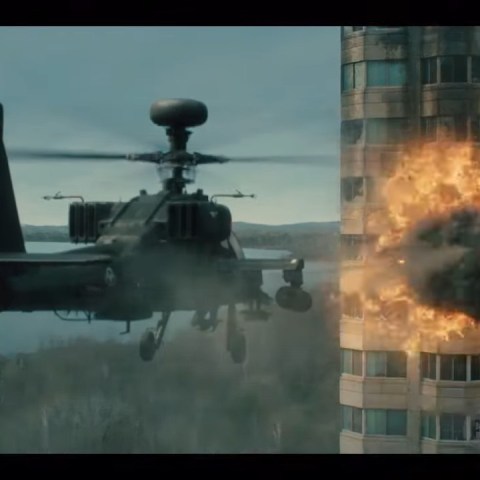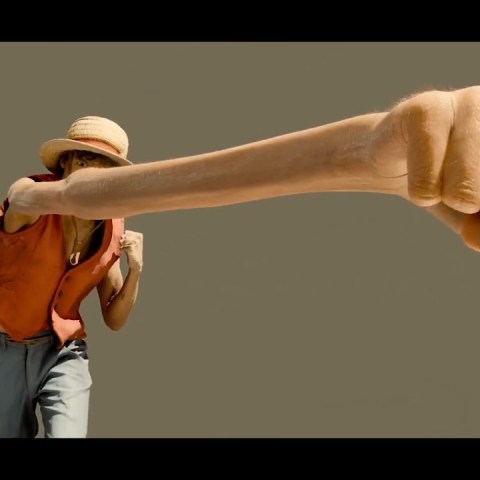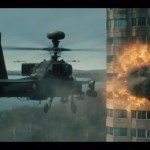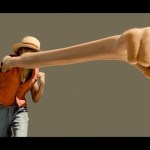Behind Framestore’s CG dog Cosmo in ‘Guardians of the Galaxy Vol. 3’.
The ‘space dog’ Cosmo, voiced by Maria Bakalova, in Guardians of the Galaxy Vol. 3 is a 100% CG dog mostly crafted by Framestore (Wētā FX also delivered some Cosmo scenes).
Based on on-set reference of a real dog (called Slate) and other dog reference, Framestore built the Cosmo asset, its speaker device and spacesuit to be a photoreal creature, starting first with a test before going into full development.
That extended also to the performance–Cosmo didn’t talk with his jaws or behave outside of any actions that a real dog could do.
Here, Framestore visual effects supervisor Stephane Naze outlines the early testing done for CG Cosmo, which included getting him ready for The Guardians of the Galaxy Holiday Special, filmed at the same time as Vol. 3 but released months earlier.
b&a: How did you find a line between creating a photoreal CG dog, but also one that wore a spacesuit and could ‘talk’?
Stephane Naze: James was very, very keen to keep the performance of the actress. He said, ‘I want to keep the vibe, I want to feel the actress in the character.’ So, it had to be a realistic dog, but you had to feel the actor behind it. Plus, it’s a dog talking through a speaker device. No lip sync, nothing. And then, it still had to be photoreal. What we said to [production visual effects supervisor] Stef Ceretti and to [director] James Gunn, was, ‘Okay, you know what? We have to be photorealistic, and that’s it. I don’t think we have to incorporate anything being cartoon or humanoid. If we do, it will completely break the spirit of this character.’
b&a: Is that what you did?
Stephane Naze: Well, they said, ‘OK, but we want to see a test.’ The thing is, it took a bit of time, because first we had to build the asset. We decided to split the test in two parts. First we would show them a CG dog that completely matched the real dog, And then, in terms of performance–ie. matching Maria Bakalova–we would show that as the second test.
We had the on-set dog for reference, but they also had a dog that they wanted to match the look to, and then we had a concept of a Cosmo dog that was in the costume and had the speaker device.
We did the first pass on the dog. James and Stef were very impressed. We did a direct side-by-side comparison in this test, and they said, ‘Oh my god, that’s exactly the dog!’ Internally, however, we were not completely happy about the results. We knew, between this first test and to get something final, it was still a long path.
Then we did the second part of the test, which was to show the dog in movement. From there, we worked in parallel. We knew we still had to improve the dog. We would do a lot of internet research, typing things like, ‘A dog being upset’ or ‘a dog being furious.’ And what you see is peoples’ interpretations of what a dog being ‘upset’ looks like. Because, in these images or pieces of footage, the dogs were not feeling human emotions in the same way we would. These were poses or expressions that people were anthropomorphizing and transposing their own emotions onto them.

b&a: Yes, that’s interesting, because there’s even some lines about, ‘Don’t tell me I’m a bad dog,’ but it all remained in the scope of what a dog might do, I thought.
Stephane Naze: Yes, and we just did this by grabbing a lot of references. We’d find one and go, ‘There, that’s matching the actress a little.’ We then built our rigs and shapes directly based on being able to follow those references. The idea was to match real footage, and not directly to deviate from that.
b&a: The character does talk, but through the speaker device. How did you deal with that?
Stephane Naze: We came with a lot of different concepts for the speaker device. We had lights moving, and wavy curves, and different things. Interestingly, for the Holiday Special, we actually had big antennae on the collar. Afterwards, James said, ‘That was good for the Holiday Special, but not for the future. Let’s go for a different design.’


b&a: When it came time to do some of those technical things like the groom, what challenges did Cosmo’s fur and hair provide?
Stephane Naze: The real challenge when we did the dog–and that’s the big difference we had between the first tests and what we did after–was to get the base under the groom. We did a lot of research, looking at videos of dog being super wet, or ones that had been completely shaved. We did that to try to define exactly what was underneath. Defining accurately what was underneath really helped with the groom. It’s all about the thickness. If some parts are too thick, when the dog moves, the groom would move in a weird way. You have different thickness everywhere on a dog.
b&a: What about the spacesuit–how did you tackle that?
Stephane Naze: I will be honest, the fact you had the dog with a spacesuit helps in terms of optimization. Because, the groom underneath doesn’t exist. We didn’t need to deal with that groom. The spacesuit itself was handled by CFX. We had a lot of conversations about thickness and rigidity. We looked at cosmonauts, how they moved, how thick their suits were. We would start with what was realistic, but then we needed to make it look cool visually, too, to see certain folds. It’s also heavily art-directed in terms of how it moves. I mean, it’s a dog in a spacesuit!




















